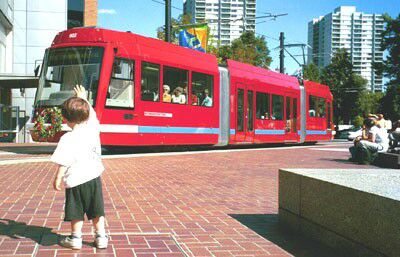
Light Rail Progress can be contacted at: Light Rail Progress |
Streetcar Plan Wins With 60% of Vote
It's streetcars for Tucson! "Voters made it clear Tuesday that they want this town's traffic woes to hit the road" declared an editorial (17 May 2006) in the Arizona Daily Star – which had backed the ballot items proposing a Regional Transportation Plan (a comprehensive bus transit/streetcar/roadway improvement program).
For more background on Tucson's LRT streetcar plans, see: With 100% of precincts reporting, results for the two propositions on the 16 May ballot were as follows:
· Prop. 1 (RTA road/transit/streetcar plan) – 60% yes
First rail starter line While, to win diverse community approval, the Tucson plan includes major roadway expansions, these do not include any new freeways. On the other hand, the modern streetcar project represents the city's first rail starter line, and perhaps a foot in the door for a more extensive system. Similarly, Denver started in the early 1990s with just a streetcar-like, street-routed light rail transit line, which was embraced by the Denver public and has since become both a catalyst for and the backbone of the urban area's massive transit expansion and New Urbanist-style transit oriented development (TOD) development program. Hopefully, events in Tucson will follow a similar pattern.
"Decisive" victory for public transport While voter turnout was light for the May 16th ballot, "the margin of victory was decisive" declared the editors of the Arizona Daily Star, adding that "By ratio of 3-2, people throughout Tucson and its surrounding suburbs agreed to add a half-cent per dollar to the sales tax to help raise $2 billion for transportation improvements over the next 20 years." "The message was inescapable" said the Star. "They've had enough of traffic congestion, aggravating bottlenecks and inadequate public transit." Turning to the streetcar project, the Star noted,
At a victory party on the election night, Tucson Mayor Bob Walkup observed, "The voters will want fast, positive action and we're going to give it to them." Steve Farley, a local artist and transit activist who had spearheaded Tucson's previous but unsuccessful LRT ballot initiative, was ecstatic over the electoral victory. "Tucson is growing up," Farley said on election night. "This is not just thrilling from a transportation standpoint. This is a template for how we solve our problems now." (Tucson Citizen, 17 May 2006) Many supporters were simply relieved that, after many efforts to rally the community behind a program of comprehensive transportation solutions, success had finally been achieved. "it is refreshing indeed that voters rejected the concerns of some very vocal critics and concluded that it's better to adopt this plan than wait for absolute gridlock to arrive before tackling the problem" said the editors of the Arizona Daily Star. Inspiration for other cities in assessing the impact of these developments on Tucson-area mobility, it's important to keep in mind that, while one light rail streetcar line is funded under this plan, more than 30 roadways will be widened or newly constructed. This is significant in view of rail critics' incessant blather about transit's declining "market share" (mode share) vis-a-vis private motor vehicle transportation. Even with improvements to bus services, it is absurd and deceptive to encourage public expectations that transit's proportional share of total travel should increase under such conditions. Nevertheless, it's clear that this is a critically important victory for high-quality public transport in the Tucson area. Furthermore, the Tucson vote is a significant success for rail advocacy – a success which can provide inspiration to other North American cities, such as Austin, Birmingham, Spokane, Madison, Columbus, Toledo, and Cincinnati, which are also considering possible streetcar systems, interurban-type light rail transit, or other light railway systems. Light Rail Now websiteURL: http://www.lightrailnow.org/news/n_tuc_2006-05b.htm Updated 2006/05/18 |
|
|
|
||